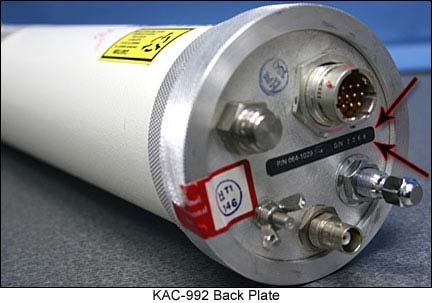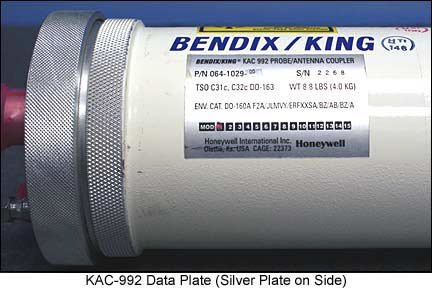| Part #: | 064-1029-00 |
|---|---|
| Model: | KAC-992 |
| Desc: | HF Probe Antenna Coupler |
| OEM: | BendixKing |
| NSN: | |
|---|---|
| Sched-B: | 8525601055 |
| ECCN: | 7A994 |
 Select part number above to view pricing and availability.
Select part number above to view pricing and availability.
| Price | Condition | Availability | Stock Info | |
|---|---|---|---|---|
| Price | Cond. | Avail. | Stock Info | |
| REQUEST | SV OUTRIGHT | REQUEST LEAD TIME |
|

KAC-992
FEATURES
- Probe/Antenna Coupler used with KHF-990 Helicopter HF system
- Used in conjunction with KTR-993 Transceiver and KFS-594 control
- Whip antenna attached to coupler
- Includes operational features such as rapid antenna tuning, maximum transmission efficiency and high reliability through elimination of maintenance-intensive mechanical assemblies
- Hermetically sealed allowing it to be mounted either totally external or with coupler section mounted internally and antenna protruding through clearance hole in aircraft skin
SPECIFICATIONS
| Size (coupler): | 3.7" diameter x 27.4"L | Size (antenna): | 1.25" diameter x 100"L |
| Environmental: | F2/A/JLMVY/ERFXXSA/BZ/AB/BZ/A | Temperature Range: | -55C to +70C |
| TSO: | FAA TSO C-31c and C-32c; RTCA DO-160A and DO-163 | Altitude: | to 55,000 feet |
| Weight (antenna): | 1.0 | Weight (coupler): | 7.8 lbs. |
| Part Number: | Description: |
|---|---|
| 064-1029-00 | 28VDC Standard version for aircraft applications |
| 064-1029-01 | 14VDC version for marine or mobile applications |
| Price | Condition | Status |
|---|---|---|
| REQUEST | SV OUTRIGHT | REQUEST LEAD TIME |
Click on a question below to see the answer. If you have a question about this model that is not answered below, please contact questions@seaerospace.com
Why do some parts indicate "REQUEST" or “RFQ” on the Southeast Aerospace website?
In relation to NE (New) parts, many OEMs change their prices and availability without any notice to dealers or the industry. Therefore, through the REQUEST or RFQ indication, we ask that customers contact us for the most accurate price and availability.
In relation to SV & OH parts, the used parts aftermarket in the aviation industry is not an infinite supply. It is a dynamic, constantly changing market that is significantly affected by and susceptible to highs and lows in supply and demand. Therefore, although we attempt to, at times, we are unable to predict the exact moment when an item may be available. Once again, through the REQUEST or RFQ indication on our website, we ask that customers contact us for the most current and accurate price and availability.
Why doesn't the KAC-992 I purchased have a dataplate?
The manufacturer will not issue new dataplates even though they are aware of this unfortunate circumstance. Therefore, the market is left with functioning and useful units that cannot be certified with an FAA approved maintenance release because the dataplate is missing and no method exists to obtain a new one.


Can the KAC-992 probe antenna coupler be used with a KHF-950 system?
No. The following is a detailed explanation of some of the technical aspects within the KHF-950 and KHF-990 that prevent the KAC-992 from being used in the KHF-950 system.
The standard KHF-950 consists of the KCU-951 Control, KTR-953 Receiver Exciter, and KAC-952 Power Amplifier/Coupler.
In the transmit mode of operation, the KTR-953 provides a low power (milliwatts) signal (at the selected frequency) to the KAC-952. This excitation signal is amplified in the KAC-952 to provide the rated output power (watts). The power amplifier is contained in the KAC-952. The KAC-952 also tunes the antenna to the desired frequency by electronically varying the antenna’s length.
The standard KHF-990 system consists of a KFS-594 control, KTR-993 R/T, and KAC-992 probe antenna coupler.
The receiver/exciter and power amplifier is contained in the KTR-993. The output of the KTR-993 is the amplified RF signal at the rated power (watts). The KAC-992 is strictly an antenna tuner and provides no amplification. Also, the KTR-953 would not provide the commands required to initiate the tuning cycle.
If the KTR-953 was installed with a KAC-992, the output of the KTR-953 would not supply adequate power to drive the KAC-992. Even if it was able to tune, the output power would be millwatts (1/1000) instead of a hundred watts.
Is an STC required for an HF system installation?
HF installations in the USA are installed and approved in the method detailed above. STCs are not required for almost all HF installations since the change to the existing aircraft Type Certificate (TC) is not so intensive as to require one.

